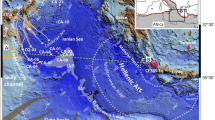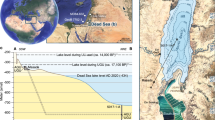Abstract
Episodes of ice-sheet disintegration and meltwater release over glacial–interglacial cycles are recorded by discrete layers of detrital sediment in the Labrador Sea1,2. The most prominent layers reflect the release of iceberg armadas associated with cold Heinrich events3, but the detrital sediment carried by glacial outburst floods from the melting Laurentide Ice Sheet is also preserved4. Here we report an extensive layer of red detrital material in the Labrador Sea that was deposited during the early last interglacial period. We trace the layer through sediment cores collected along the Labrador and Greenland margins of the Labrador Sea. Biomarker data, Ca/Sr ratios and δ18O measurements link the carbonate contained in the red layer to the Palaeozoic bedrock of the Hudson Bay. We conclude that the debris was carried to the Labrador Sea during a glacial outburst flood through the Hudson Strait, analogous to the final Lake Agassiz outburst flood about 8,400 years ago, probably around the time of a last interglacial cold event in the North Atlantic5. We suggest that outburst floods associated with the final collapse of the Laurentide Ice Sheet may have been pervasive features during the early stages of Late Quaternary interglacial periods.
This is a preview of subscription content, access via your institution
Access options
Subscribe to this journal
Receive 12 print issues and online access
$259.00 per year
only $21.58 per issue
Buy this article
- Purchase on Springer Link
- Instant access to full article PDF
Prices may be subject to local taxes which are calculated during checkout




Similar content being viewed by others
References
Channell, J. E. T. et al. Expedition 303 summary Proc. IODP 303/306,http://dx.doi.org/10.2204/iodp.proc.303306.101.2006 (2006).
Channell, J. E. T. et al. A 750-kyr detrital-layer stratigraphy for the North Atlantic (IODP Sites U1302–U1303, Orphan Knoll, Labrador Sea). Earth Planet. Sci. Lett. 317, 218–230 (2012).
Broecker, W., Bond, G., Klas, M., Clark, E. & McManus, J. Origin of the northern Atlantic’s Heinrich events. Clim. Dynam. 6, 265–273 (1992).
Shaw, J. & Lesemann, J-E. Subglacial outburst floods and extreme sedimentary events in the Labrador Sea. Geol. Soc. Amer. Special Papers 370, 25–41 (2003).
Oppo, D. W., McManus, J. F. & Cullen, J. L. Evolution and demise of the Last Interglacial warmth in the subpolar North Atlantic. Quat. Sci. Rev. 25, 3268–3277 (2006).
Deaton, B. & Balsam, W. L. Visible spectroscopy—A rapid method for determining hematite and goethite concentration in geological materials. J. Sediment. Res. 61, 628–632 (1991).
Hodell, D. A., Channell, J. E. T., Curtis, J. H., Romero, O. E. & Röhl, U. Onset of Hudson Strait Heinrich events in the eastern North Atlantic at the end of the middle Pleistocene transition (∼ 640 ka)? Paleoceanography 23, PA4218 (2008).
Hodell, D. A. & Curtis, J. H. Oxygen and carbon isotopes of detrital carbonate in North Atlantic Heinrich Events. Mar. Geol. 256, 30–35 (2008).
Rosell-Mele, A., Maslin, M. A., Maxwell, J. R. & Schaeffer, P. Biomarker evidence for Heinrich events. Geochim. Cosmochim. Acta 61, 1671–1678 (1997).
Rashid, H. & Grosjean, E. Detecting the source of Heinrich layers: An organic geochemical study. Paleoceanography 21, PA3014 (2006).
Naafs, B. D. A., Hefter, J., Ferretti, P., Stein, R. & Haug, G. H. Sea surface temperatures did not control the first occurrence of Hudson Strait Heinrich Events during MIS 16. Paleoceanography 26, PA4201 (2011).
Hemming, S. R. Heinrich Events: Massive Late Pleistocene detritus layers of the North Atlantic and their global climate imprint. Rev. Geophys. 42, RG1005 (2004).
Hillaire-Marcel, C., De Vernal, A. D. & Mckay, J. Foraminifer isotope study of the Pleistocene Labrador Sea, northwest North Atlantic (IODP Sites 1302/03 and 1305), with emphasis on paleoceanographical differences between its inner and ‘outer’ basins. Mar. Geol. 279, 188–198 (2011).
Lototskaya, A. & Ganssen, G. M. The structure of Termination II (penultimate deglaciation and Eemian) in the North Atlantic. Quat. Sci. Rev. 18, 1641–1654 (1999).
Rasmussen, T. L. Deep sea records from the southeast Labrador Sea: Ocean circulation changes and ice-rafting events during the last 160,000 years. Paleoceanography 18, 1018 (2003).
Evans, H. F. et al. Paleointensity-assisted chronostratigraphy of detrital layers on the Eirik Drift (North Atlantic) since marine isotope stage 11. Geochem. Geophys. Geosyst. 8, Q11007 (2007).
Hillaire-Marcel, C. & Bilodeau, G. Instabilities in the Labrador Sea water mass structure during the last climatic cycle. Can. J. Earth Sci. 37, 795–809 (2000).
Hillaire-Marcel, C., De Vernal, A. & Piper, D. J. W. Lake Agassiz final drainage event in the northwest North Atlantic. Geophys. Res. Lett. 34, L15601 (2007).
Hesse, R., Khodabakhsh, S., Klaucke, I. & Ryan, W. B. F. Asymmetrical turbid surface-plume deposition near ice-outlets of the Pleistocene Laurentide ice sheet in the Labrador Sea. Geo-Mar. Lett. 17, 179–187 (1997).
Hesse, R. Drainage systems associated with mid-ocean channels and submarine yazoos: Alternative to submarine fan depositional systems. Geology 17, 1148–1151 (1989).
Hillaire-Marcel, C., de Vernal, A., Bilodeau, G. & Wu, G. Isotope stratigraphy, sedimentation rates, deep circulation, and carbonate events in the Labrador Sea during the last ∼ 200 ka. Can. J. Earth Sci. 31, 63–89 (1994).
Stoner, J. S., Channell, J. E. T. & Hillaire-Marcel, C. The magnetic signature of rapidly deposited detrital layers from the deep Labrador Sea: Relationship to North Atlantic Heinrich layers. Paleoceanography 11, 309–325 (1996).
Kerwin, M. W. A regional stratigraphic isochron (ca. 8000 14C yr B.P.) from final deglaciation of Hudson Strait. Quat. Res. 46, 89–98 (1996).
St-Onge, G. & Lajeunesse, P. Flood-induced turbidites from northern Hudson Bay and western Hudson Strait: A two-pulse record of Lake Agassiz final outburst flood? Submar. Mass Mov. Consequences 27, 129–137 (2007).
Lajeunesse, P. & St-Onge, G. The subglacial origin of the Lake Agassiz–Ojibway final outburst flood. Nature Geosci. 1, 184–188 (2008).
Carlson, A. E. Why there was not a Younger Dryas-like event during the penultimate deglaciation. Quat. Sci. Rev. 27, 882–887 (2008).
Shilts, W. W. in Glaciation of the Hudson Bay region. (ed. Martini, I. P.) 55–78 (Canadian Inland Seas, Elsevier Oceanography Series, 1986).
Alley, R. B. et al. Holocene climatic instability: A prominent, widespread event 8200 yr ago. Geology 25, 483–486 (1997).
Barber, D. C. et al. Forcing of the cold event of 8,200 years ago by catastrophic drainage of Laurentide lakes. Nature 400, 344–348 (1999).
Clark, P. U. et al. Freshwater forcing of abrupt climate change during the last glaciation. Science 293, 283–7 (2001).
Acknowledgements
We thank I. N. McCave for insightful discussion and suggestions for the paper. M. Hall, J. Rolfe and S. Crowhurst provided technical assistance. W. Hale and A. Wülbers at the Bremen Core Repository assisted with sampling, U. Rohl, V. Lukies and T. Westerhold at MARUM for assistance with XRF core scanning. This research used samples provided by the Integrated Ocean Drilling Program (IODP). Financial support for this research was provided by NERC Grant NE/H009930/1 to D.A.H. and NERC studentship to J.A.L.N. B.D.A.N. acknowledges financial support from DFG-grant NA973/1-1 and J.E.T.C from National Science Foundation Grant OCE-0850413.
Author information
Authors and Affiliations
Contributions
J.A.L.N. and D.A.H. conceived the project, collected and interpreted the data, and drafted the paper. J.E.T.C. and D.A.H. identified site locations and collected the cores during IODP Expedition 303. B.D.A.N. performed the biomarker analysis and interpreted the data. C.H-M. produced the oxygen isotope stratigraphies. All authors contributed to data interpretation and the writing of the paper.
Corresponding authors
Ethics declarations
Competing interests
The authors declare no competing financial interests.
Supplementary information
Supplementary Information
Supplementary Information (PDF 951 kb)
Rights and permissions
About this article
Cite this article
Nicholl, J., Hodell, D., Naafs, B. et al. A Laurentide outburst flooding event during the last interglacial period. Nature Geosci 5, 901–904 (2012). https://doi.org/10.1038/ngeo1622
Received:
Accepted:
Published:
Issue Date:
DOI: https://doi.org/10.1038/ngeo1622
This article is cited by
-
Weakened AMOC related to cooling and atmospheric circulation shifts in the last interglacial Eastern Mediterranean
Nature Communications (2023)
-
Pre-aged terrigenous organic carbon biases ocean ventilation-age reconstructions in the North Atlantic
Nature Communications (2023)
-
Rapid northern hemisphere ice sheet melting during the penultimate deglaciation
Nature Communications (2022)
-
Concerns of assuming linearity in the reconstruction of thermal maxima
Nature (2022)
-
Giant clam (Tridacna) distribution in the Gulf of Oman in relation to past and future climate
Scientific Reports (2022)



